Garden Marco Polo and Garden Robert Cavelier de la Salle
The Garden of the Observatory
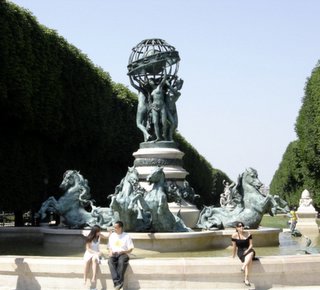
Garden Marco Polo and Garden Robert Cavelier de la Salle
Metro: Raspail
RER: Port Royal
Arrondissement: 6eme, Avenue de l'Observatoire
Go Here for Hotels in this Area
The Jardin Marco Polo and the Garden Robert Cavelier, also known as the Garden of the Observatory, le Jardin de l'Observatoire, are situated between the Luxembourg Gardens and Boulevard Montparnasse on Avenue de l'Observatoire.
The Garden Marco Polo occupies the southern half of the Avenue de l'Observatoire, from Boulevard Montparnasse to Rue Michelet, covering just under 3 acres, or just over 1 hectare.
The Jardin Robert Cavelier de la Salle is slightly larger and occupies the northern portion from Rue Michelet to the Luxembourg Garden. Both parks were created in 1867.
The Garden Marco Polo is named to honor Marco Polo (1254-1324), known as one of the great explorer's of the world.
The Garden Robert Cavelier de la Salle is named to honor the French explorer Cavelier (1643-1687) who explored the Great Lakes region of North America, the Gulf of Mexico and the Mississippi River. It was Cavelier de la Salle who claimed the entire Mississippi basin as French territory.
The area of the Garden Marco Polo and the Garden Robert Cavelier de la Salle was previously occupied by the southern portion of the Castle Vauvert, built by King Robert le Pieux, son of Hugues Capet.
This château was famous for having been reputedly inhabited by the Devil. This legend brought about the French expression, envoyer au diable Vauvert, "send it to the Vauvert devil", or aller au diable Vauvert, "go to the Vauvert devil".
The Château Vauvert was given to the monks of Chartre in 1257 and became a monastery. However, in 1790, during the Revolution, the monks were driven out and the castle was destroyed.
In 1796, the Luxembourg Gardens took some of this vacated land while the rest was later developed into the Avenue de l'Observatoire. The width of this avenue was doubled in 1840 to its present width of 100 meters.
In 1867, the two gardens, the Garden Marco Polo and the Garden Robert Cavelier de la Salle, were created by architect Chalgrin between the Garden of the Luxembourg and the Observatory of Paris.
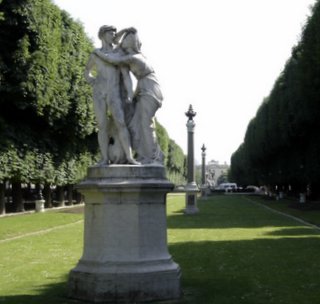
Each of these gardens have lawns and are planted with four rows of chestnut trees which are sharply trimmed in the classic French-style providing shaded walkways.
Both gardens are also planted with flower beds that surround several statues by the most famous sculptors of the Second Empire.
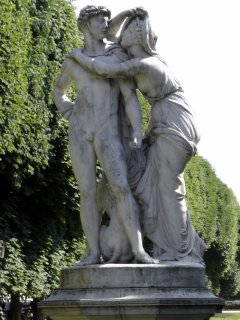
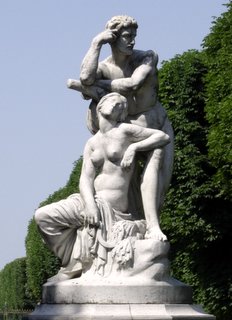
In the Jardin Robert Cavelier de la Salle is found the stone sculpture made by Charles Alphonse Achilles Gumery called La Nuit, Night. There is also the stone sculpture made by Gustave Grauk in 1870 called, Le Crépuscule, Twilight.
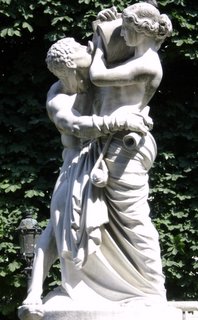
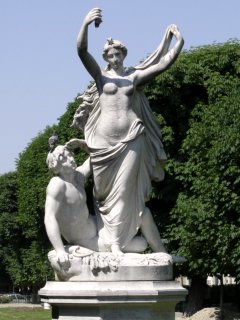
In the Garden Marco Polo is found a stone sculpture created by Jean-Joseph Perraud during 1870-1875 called Le Jour, Day, and a sculpture made of stone by François Jouffroy called L'Aurore, Dawn, created during 1870-1875.
At the southern end of the Garden Marco Polo, near the Place Camille-Jullian, sits the celebrated Fontaine des Quatre Parties du Monde, Fountain of the Four Parts of the World. It was designed and supervised by Gabriel Davioud and it was created during 1867-1874.
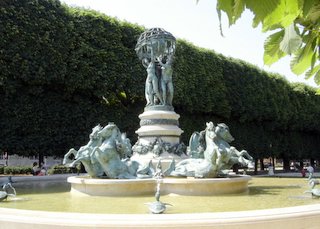
It is a collective work portraying in bronze four continents of the world; Asia, Europe, Africa and America. Asia is represented by the figure of a Chinese woman; Europe is represented by the figure of a white woman; Africa is represented by the figure of a black woman and America is represented by the female figure of an American Indian. These were created by Jean Baptiste Carpeaux.
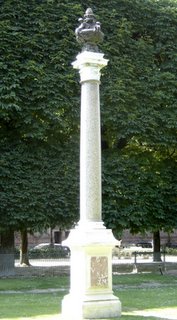
It also has the figures of eight dolphins, horses and tortoises made by Emmanuel Frémiet. The garlands surrounding the pedestal were done by Luis Vuillemot. The sphere was created by Pierre Legrain. The sculpture was foundried by Matifat in 1873 and it was constructed in 1874.
Interspersed between the sculptures are free-standing columns. These offer a beautiful classic simplicity and perspective to the Gardens.
Amongst the double rows of chestnut trees are many benches for resting and enjoying the shade. Both Gardens have children's playgrounds and several ping-pong tables.
The Garden Marco Polo and the Garden Robert Cavelier de la Salle open from 8 a.m. Monday-Friday and 9 a.m. Saturday and Sunday, closing at 6 p.m. in the winter and 9 p.m. in the summer.
Return to Top of Garden Marco Polo
Private Tours
| Paris Introduction Tour | Paris Islands Tour | Paris Passages Tour |
| Trocodero-Eiffel-Invalides | Marais Tour | Montmartre Tour |
| Latin Quarter Tour | Paris Markets Tour | Paris Churches Tour |
Booking.com
New! Comments
Have your say about what you just read! Leave me a comment in the box below.